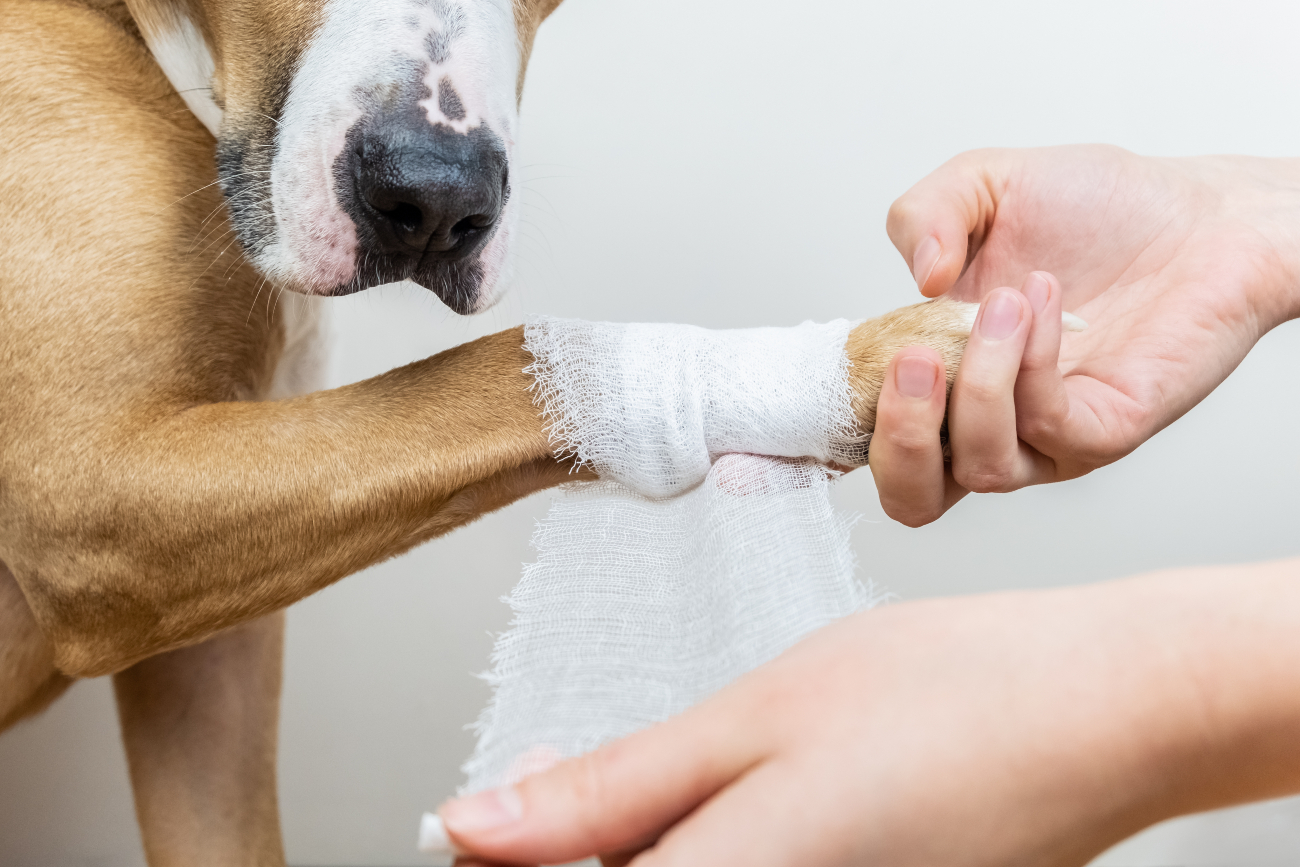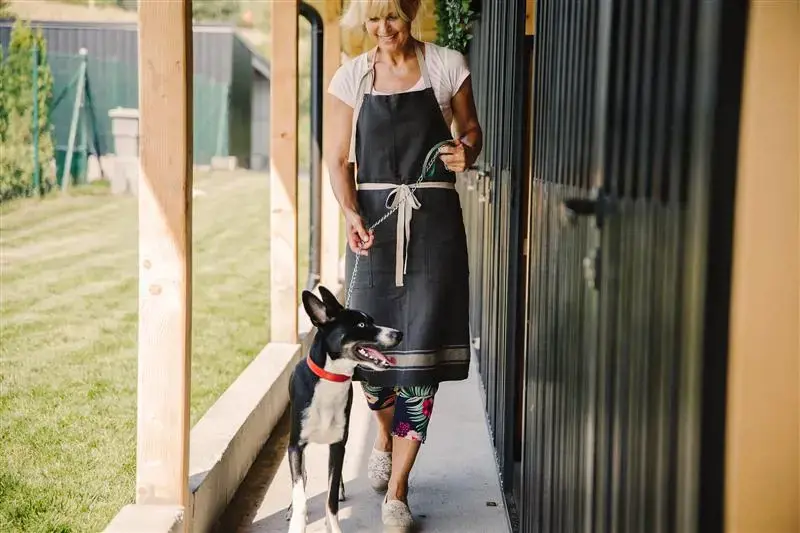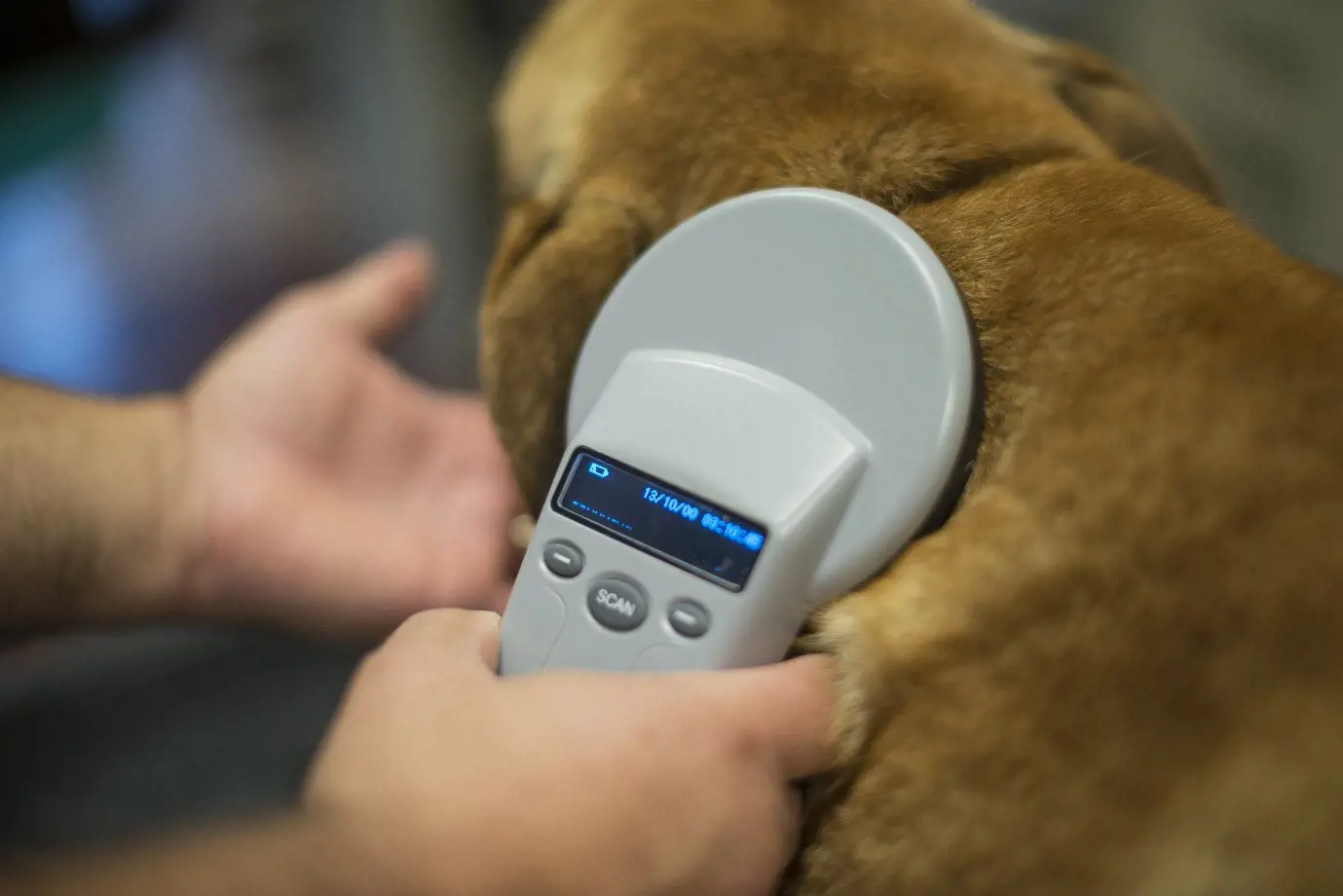How to cover a dog wound
12th March, 2024

As an attentive pet parent, ensuring your furry friend’s well-being is always a top priority. However, accidents can happen, and it’s essential to know how to properly care for your dog’s wound when they occur.
In this comprehensive guide on “how to cover a dog wound”, we will walk you through the steps to effectively manage various types of wounds, from lacerations to burns, to help your four-legged companion return to their playful self in no time.
By understanding the types and risks of dog wounds, gathering the necessary supplies, and following a step-by-step wound care process, you can minimise the impact of injuries and ensure your dog’s speedy recovery.
Let’s dive into the world of dog wound care and equip you with the knowledge you need to confidently care for your canine companion.
Key takeaways
- Understand the type of wound and associated risks before treating a dog’s injury.
- Have necessary supplies on hand, including cleaning solutions, bandaging materials and additional items like muzzles or clippers.
- Seek professional advice from a veterinarian to ensure your pet receives the best care for their wound.
Understanding dog wounds: Types and risks
Recognising and understanding the different types of dog wounds and their associated risks is key, as the appropriate management varies according to the injury. From lacerations to puncture wounds and abrasions, each type of wound poses unique challenges and potential complications.
Knowing how to identify these wounds and their risks enables you to act quickly and provide the appropriate care to prevent infection and promote healing.
Lacerations
Lacerations are cuts or tears in the skin that can vary in severity, and in some cases, may require stitches. Proper treatment of a laceration necessitates the following steps:
- Trim the fur around the wound using quiet, pet-specific clippers. This helps maintain the wound’s cleanliness and prevents bacteria from accumulating.
- Clean the wound with warm tap water or saline solution.
- Apply a topical antibiotic ointment to the wound.
- Bandage the wound with a sterile gauze pad and wrap it firmly around the wound to ensure it stays clean and protected.
In some cases, lacerations may require surgical closure or suturing to prevent infection and promote proper healing. If you are unsure of the severity of the laceration or the appropriate course of action, it’s always best to consult with a veterinarian for specific instructions.
Punctures
Puncture wounds, including bite wounds, are small holes caused by sharp objects or bites that can be particularly dangerous, leading to infection or internal damage.
Due to their depth and the potential for contamination, puncture wounds, which can be considered as a type of open wounds and minor wound, require careful cleaning and monitoring, similar to the care needed for surgical wounds.
If the wound is caused by a bite, it’s important to consider the risk of rabies, especially if the animal responsible has an unknown vaccination status or is a wild animal.
Should you suspect a puncture wound in your dog, seek guidance from your veterinarian on treatment and necessary precautions. In some cases, a thorough wound evaluation, decontamination, and surgical closure may be required.
Abrasions
Abrasions are scrapes or scratches on the skin, which can be painful and prone to infection. Proper care for abrasions includes:
- Cleaning the wound with mild soap and water
- Applying an antibiotic ointment
- Covering the wound with a bandage to avoid exposure to dirt or other contaminants
Keeping the wound clean and dry is imperative to prevent infection and facilitate healing.
If the abrasion does not improve or shows signs of infection, such as redness, swelling, or pus, consult your veterinarian for further guidance and treatment.
Burns
Burns in dogs can result from various causes, including heat, chemicals, or friction. The treatment for burns depends on the severity of the injury. Mild burns can be managed with topical ointments and bandages, while more serious burns may necessitate antibiotics or other medications.
Monitoring the wound and ensuring its correct healing is of utmost importance. Be vigilant for any potential signs of infection, such as redness, swelling, or discharge. If the burn does not improve or worsens, seek veterinary care for further assessment and treatment.
Preparing for dog wound care: Essential supplies

Preparation with essential supplies for dog wound care saves time and aids in ensuring correct treatment. Having a well-stocked doggy first aid kit can make all the difference when it comes to your dog’s healing process.
Being equipped with necessary supplies, from cleaning solutions to bandaging materials and additional items like a muzzle and clippers, is pivotal in effectively managing your dog’s wound.
Cleaning solutions
Using the appropriate cleaning solutions for your dog’s wound is vital to promote healing and prevent infection. Non-stinging antiseptic solutions, such as 2% chlorhexidine or povidone-iodine, are recommended for cleaning dog wounds. Povidone-iodine is particularly suitable for wounds near a dog’s eyes.
Avoiding the use of alcohol, hydrogen peroxide, and herbal products unless specifically recommended by a veterinarian is important, as they may delay healing and hinder the wound healing process. Always follow your veterinarian’s instructions for cleaning solutions to ensure the best outcome for your dog’s wound care.
Bandaging materials
Proper bandaging materials are crucial for protecting your dog’s wounds and promoting healing. Essential items for bandaging include:
- Bandage scissors
- Sterile gauze or dressing
- Cotton roll or bandage padding
- Elastic wrapping
These materials, including adhesive tape, help keep the wound clean and prevent further harm and contamination.
Using proper bandaging techniques is important to guarantee adequate wound protection. When applying a bandage, make sure the sterile gauze pad completely covers the wound and that the bandage is wrapped firmly but not excessively tight to avoid restricting blood flow. Check out our guide on how to bandage a dog’s ear tip on our site for a few extra tips.
Additional items
In addition to cleaning solutions and bandaging materials, other items are necessary for effective dog wound care. A muzzle is essential for securing your dog during the wound care process to prevent biting and ensure proper assessment and treatment. Clippers are crucial for trimming the hair around the wound to maintain cleanliness and prevent bacterial accumulation.
Other items, such as tweezers for removing splinters or foreign material, may also be required depending on the type of wound and the specific needs of your dog. Having a well-stocked pet first aid kit that includes these additional items is crucial to ensure optimal care for your dog’s injury.
Step-by-step guide to covering a dog wound
Understanding how to appropriately treat and cover a dog wound is pivotal for the promotion of healing and prevention of complications. Following a step-by-step guide ensures you’re providing the best care possible for your furry friend.
From securing your dog to cleaning and bandaging the wound, each step plays an essential role in the wound care process.
Securing your dog
Before beginning the treatment of your dog’s wound, ensure its security with a muzzle or other restraint. This helps to maintain stability of the wound. Consequently, it’s much easier to assess and treat the injury correctly without causing any further damage. Ensuring your dog is secure and comfortable during the process is vital for their well-being and the effectiveness of the treatment.
It’s important to remain calm and reassure your dog during the wound care process. Your demeanour can have a significant impact on their comfort level and cooperation. Providing a calm and reassuring environment will make the treatment process smoother and more efficient for both you and your dog.
Assessing the wound
Following the security of your dog, the subsequent step involves assessing the wound to ascertain its severity and decide the appropriate course of action. Cautiously observe the wound for any indications of:
- Bleeding
- Swelling
- Redness
- Discharge
Evaluating the depth and size of the wound, as well as any underlying structures that may be impacted, is crucial for determining the best treatment plan.
If you are unsure of the severity of the wound or the appropriate course of action, it’s always best to consult with a veterinarian for specific instructions and guidance. They can provide expert advice on how to proceed and whether any additional care, such as suturing or antibiotics, is necessary.
Cleaning the wound
The wound must be cleaned with suitable solutions to remove debris and bacteria, which promotes healing and prevents infection. Use non-stinging antiseptic solutions or warm tap water to gently clean the wound, removing any dirt or foreign material.
After cleaning the wound, gently pat it dry with a clean cloth or gauze to ensure it remains clean and free of contaminants. Be thorough but gentle during the cleaning process to avoid causing additional pain or damage to the wound.
Applying antibiotic ointment
The application of antibiotic ointment to the wound is a vital step to promote healing and prevent infection. After cleaning the wound with a mild antiseptic solution, apply a thin layer of antibiotic ointment, such as a triple antibiotic ointment containing bacitracin and neomycin.
It is important to adhere to any instructions or recommendations provided by your veterinarian when applying antibiotic ointment. Proper application ensures the wound remains clean and minimises the risk of infection or other complications.
Bandaging the wound
The concluding step in the wound care process involves correctly bandaging the closed wound to shield it from further damage and prevent contamination. Utilise a sterile gauze pad and wrap it firmly around the wound, ensuring a 100% overlap to secure it in place.
When bandaging your dog’s wound, ensure the bandage is snug but not too tight, as this can restrict blood flow and cause additional complications. One to two fingers should fit into the top of the bandage to ensure it is secure and comfortable for your dog.
Ongoing care and monitoring
Following the proper treatment and bandaging of the wound, ongoing care and monitoring become vital for a successful healing process. By preventing licking and chewing, maintaining the bandage, and knowing when to seek veterinary care, you can optimise your dog’s recovery and minimise the risk of complications.
Preventing licking and chewing
Further damage to the wound and increased risk of infection can result from licking and chewing. To prevent your dog from engaging in this behaviour, use an Elizabethan collar or protective clothing, such as a dog coat or t-shirt. These protective measures not only keep the wound clean but also deter your dog from causing additional harm to the affected area. To learn more about other types of collars, check out our blog on how to choose the best collar and lead for your dog.
In addition to physical barriers, you can also use behavioural deterrents, such as bitter-tasting sprays or ointments, to discourage licking and chewing. However, it’s important to consult your veterinarian before using any products to ensure they are safe and appropriate for your dog’s specific needs.
Bandage maintenance
Keeping the bandage clean and dry is a crucial factor in promoting healing and preventing infection. Here are some steps to follow:
- Change the bandage every one to two days, or if it becomes wet or dirty.
- When changing the bandage, clean the wound with a mild soap and water solution.
- Ensure the wound is completely dry before reapplying the bandage.
Keeping a close eye on the bandage and the wound itself will help you identify any potential issues early on. If you notice any unusual changes, such as increased redness, swelling, or discharge, consult your veterinarian for further guidance and treatment.
When to seek veterinary care
Knowing when to seek veterinary care is important, even though many dog wounds can be managed at home with proper care and monitoring. If your dog’s wound does not heal as expected, shows signs of infection, or if your dog suddenly appears to be more affected by it, consult your veterinarian for further assessment and treatment.
Your veterinarian can provide expert advice on the appropriate course of action, whether it’s additional treatments, medications, or further monitoring. Trusting your instincts as a pet parent and seeking professional guidance when necessary ensures your dog receives the best possible care.
Should you cover an open wound on a dog?
It is generally advisable to cover an open wound on a dog to keep them from licking it and promoting bacterial growth. To prevent further issues, the bandage should be changed at least 3x per day and replaced with a clean one.
What should I put on my dog's open wound?
Clean your dog's wound two to three times daily with warm salt water, and apply a thin layer of antimicrobial ointment such as 2% chlorhexidine. If necessary, use an Elizabethan collar to prevent self-trauma. Avoid hydrogen peroxide or any other disinfectant unless recommended by a vet.
Does a dog wound heal faster covered or uncovered?
For optimal healing, it is best to keep a dog wound covered as this helps protect against infection and keeps the wound moist. Avoid wrapping too tightly however, as this could impair healing.
What are the main types of dog wounds?
The main types of dog wounds are lacerations, punctures, abrasions, and burns. Each type presents its own challenges and potential complications.
How can I prevent my dog from licking and chewing their wounds?
Protect your dog from licking and chewing their wound by using an Elizabethan collar or protective clothing, and using deterrents like bitter-tasting sprays or ointments.
Summary

In conclusion, understanding the various types of dog wounds and their associated risks, having the necessary supplies on hand, and following a step-by-step guide to wound care can make all the difference when it comes to your dog’s recovery. The importance of ongoing care and monitoring cannot be overstated, as it ensures your dog’s wound remains clean, heals properly, and minimises the risk of complications.
As a responsible pet parent, you now possess the knowledge and tools needed to confidently care for your dog’s wounds. By being prepared and proactive, you can help your furry friend return to their happy and healthy self in no time.
To get a dog insurance quote for your furry friend you can get a quote through our website. If you would like to talk to one of our dog insurance specialists, you can get in touch with us on 0330 102 5748.
Helpful Pages
Recent Posts
Pet Insurance Quote
- 98% claims paid *
- Claims paid directly to vets
- 24/7 vet video consultations
- Interest free monthly payments




